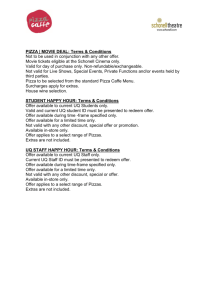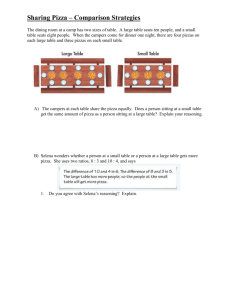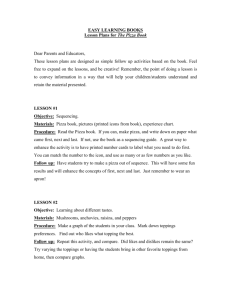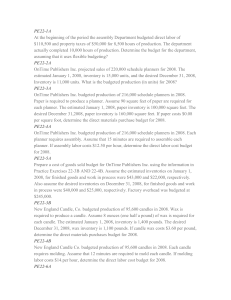five major decision areas
advertisement
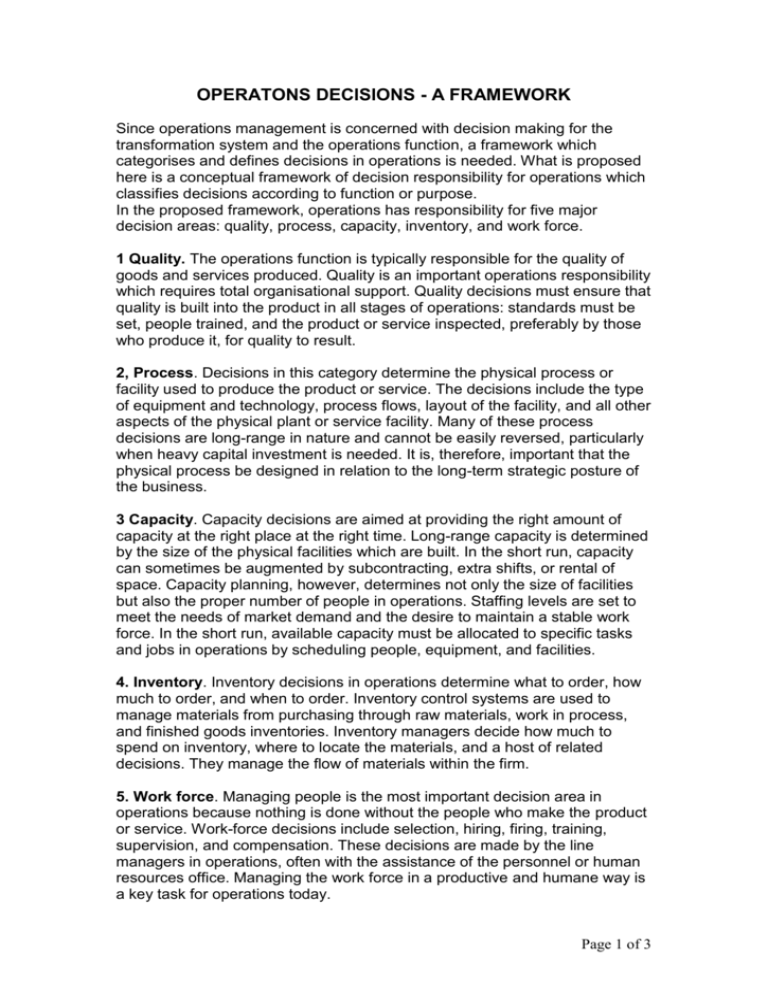
OPERATONS DECISIONS - A FRAMEWORK Since operations management is concerned with decision making for the transformation system and the operations function, a framework which categorises and defines decisions in operations is needed. What is proposed here is a conceptual framework of decision responsibility for operations which classifies decisions according to function or purpose. In the proposed framework, operations has responsibility for five major decision areas: quality, process, capacity, inventory, and work force. 1 Quality. The operations function is typically responsible for the quality of goods and services produced. Quality is an important operations responsibility which requires total organisational support. Quality decisions must ensure that quality is built into the product in all stages of operations: standards must be set, people trained, and the product or service inspected, preferably by those who produce it, for quality to result. 2, Process. Decisions in this category determine the physical process or facility used to produce the product or service. The decisions include the type of equipment and technology, process flows, layout of the facility, and all other aspects of the physical plant or service facility. Many of these process decisions are long-range in nature and cannot be easily reversed, particularly when heavy capital investment is needed. It is, therefore, important that the physical process be designed in relation to the long-term strategic posture of the business. 3 Capacity. Capacity decisions are aimed at providing the right amount of capacity at the right place at the right time. Long-range capacity is determined by the size of the physical facilities which are built. In the short run, capacity can sometimes be augmented by subcontracting, extra shifts, or rental of space. Capacity planning, however, determines not only the size of facilities but also the proper number of people in operations. Staffing levels are set to meet the needs of market demand and the desire to maintain a stable work force. In the short run, available capacity must be allocated to specific tasks and jobs in operations by scheduling people, equipment, and facilities. 4. Inventory. Inventory decisions in operations determine what to order, how much to order, and when to order. Inventory control systems are used to manage materials from purchasing through raw materials, work in process, and finished goods inventories. Inventory managers decide how much to spend on inventory, where to locate the materials, and a host of related decisions. They manage the flow of materials within the firm. 5. Work force. Managing people is the most important decision area in operations because nothing is done without the people who make the product or service. Work-force decisions include selection, hiring, firing, training, supervision, and compensation. These decisions are made by the line managers in operations, often with the assistance of the personnel or human resources office. Managing the work force in a productive and humane way is a key task for operations today. Page 1 of 3 Careful attention to the five decision areas is the key to management of successful operations. Indeed, the well-managed operations function can be defined in terms of the decision framework. If each of the five decision areas is functioning properly and well integrated with the other areas, the operations function can be considered well managed. DECSON FRAMEWORK. - EXAMPLE To illustrate the use of the decision framework, a company will be described in terms of the five decision categories. The example is a simplified description of Pizza U.S.A., Inc., a company which produces and markets pizza pies on a national basis. It consists of 85 company-owned and franchised outlets (each called a store) in the United States. The operations management function in this company exists at two levels: the corporate level and the level of the individual store. The major operations decisions made by Pizza U.S.A. can be described as follows: Quality. The corporate staff has set certain standards for quality which all stores must follow. These standards include procedures to maintain service quality and to ensure the quality of the pizzas served. While service quality is difficult to measure, the quality of the pizzas can be more easily specified by using criteria such as temperature at serving time, the amount of raw materials used in relation to standards, and so on. In Pizza U.S.A., each store manager must carefully monitor quality to make sure that it meets company standards. Each employee is responsible for quality in their job in order to ensure that quality is “produced at the source.” Process. Since uniformity across different stores is desired, most of the process decisions are made by the corporate staff. They have developed a standard facility which is simply sized to fit a particular location. The standard facility incorporates a limited menu with high-volume equipment. As pizzas are made, customers can watch the process through a glass window; this provides entertainment for both children and adults as they wait for their order to be filled. Because this is a service facility, special care is taken to make the layout attractive and convenient for the customers. The location of facilities is based on a mathematical model which is used to project revenues and costs for particular sites. Each potential site must have an adequate projected return on investment before construction can begin. Capacfty, Pizza U.S.A. faces a series of decisions related to the maximum level of output. First, when the initial location and process decisions are made, the corporate staff fixes the physical capacity of each facility. Individual store managers then plan for annual, monthly, and daily fluctuations in service capacity within the available physical facility. During peak periods, they employ part-time help, and advertising is used in an attempt to raise demand during slack periods. In the short run, individual personnel must be scheduled in shifts to meet demand during store hours. Page 2 of 3 Inventory. The individual store managers buy the ingredients required to prepare the recipes provided by corporate staff. They select their own suppliers and decide how much flour, tomato paste, sausage, etc., to order and when to place orders. Store operators must carefully integrate purchasing and inventory decisions to control the flow of materials in relation to capacity. They do not want to run out of food during peak periods or waste food when demand is low. Work Force, Store managers are responsible for hiring, training, supervising, and, if necessary, firing workers. They must decide on exact job responsibilities and on the number of people needed to operate the store. They also advertise job openings, screen applications, interview candidates, and make the hiring decisions. They must measure the amount of work required in relation to production and also evaluate the performance of each individual. Management of the work force is one of the most important daily responsibilities of the store manager. The five decision categories provide a framework to describe the important operations decisions made by Pizza U.S.A. It should be recognized, however, that these five types of decisions cannot be made separately; they must be carefully integrated with one another and with decisions made in other parts of the business. RG Schroeder, Operations Management, 4edition, 1993, McGraw Hill (pp16-20) Page 3 of 3


